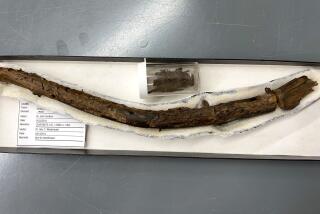Cutting Back
- Share via
Yellow and orange calendulas are old standbys for winter color. To prolong their bloom, cut off faded flowers to stop the plants from putting their energy into seed. The double daisy-like bloom makes a striking contrast with the blue of pansies or violas.
After summer bulbs (such as dahlias, tuberous begonias and gloxinia) die down, they can be dug and stored in vermiculite to keep them dry during winter dormancy. Cold and dampness encourage rot.
Watsonias are corms from Southern Africa that are easily grown and will multiply. The foliage is similar to that of gladiolus, but the flowers are smaller and more tubular. Watsonias, especially the white ‘Mrs. Bullard,’ are popular with serious flower arrangers. Other common colors are pink, soft pink and lavender. There is also an evergreen, hard-to-find species, W. beatricis , with apricot-to-red flowers. Watsonias get overcrowded and should be divided every four or five years.
Roses can be bought in bloom in five-gallon cans at the nurseries. For fragrance, stem length and overall appearance, it’s best to see the actual rose; colored pictures are no substitute. If you are planning to buy bare-root roses in December or January, it’s worth a trip to the garden at Exposition Park to see a wide assortment of roses in bloom.
English primroses and their hybrids are magnificent plants for the cool California winter and spring. They come in most colors of the rainbow, and that they are available in flats, six-packs, four-inch pots and gallon cans attests to their popularity. For truly sensational plants, fertilize twice a month with liquid fertilizer at one-half the recommended strength (it can be sprayed over the leaves for foliar feeding). Though English primroses are perennials, it is somewhat difficult to pull them through the hot, dry summer.
When planting vegetables this month and next, ignore the maturity dates listed on the seed packets and in seed catalogues. Those dates are for planting in the spring, when the long days promote optimum plant growth. Because of the shorter daylight hours during the late fall and winter, it takes vegetables much longer to reach the harvest stage.
Terra-cotta strawberry jars don’t have to be restricted to strawberry plants; they make ideal miniature herb gardens. Place different herbs in the individual cutouts, and their contrasting foliages and mixed scents will make an attractive and useful item for your kitchen doorstep. When planting your jar, put trailing herbs in the lower cutouts and upright herbs in the upper openings.
A fall cleanup program will prove most helpful in decreasing your pest problems next spring. Insects and diseases tend to winter in plant debris. Snails and slugs are a particular problem now, as they can decimate leafy vegetables almost overnight. An immaculate garden and strict vigilance are the best defenses. Never compost plant materials that are likely to harbor insects, diseases or weed seeds.






